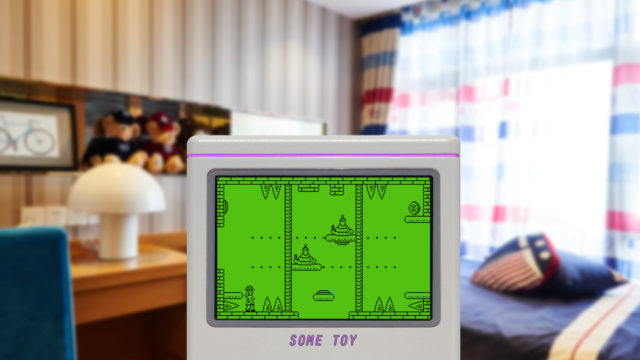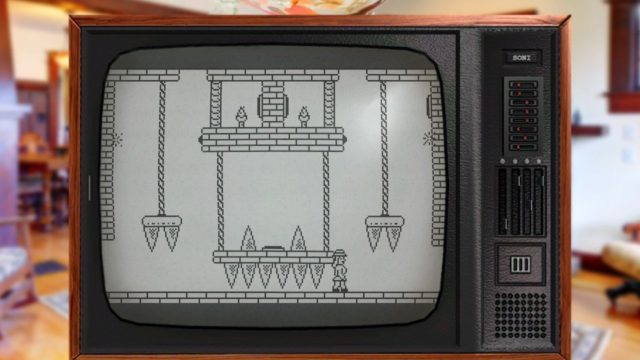Tight controls; great setup; fun, old-school gameplay
Too short; little replay value; the setup feels squandered
It’s no secret that the video game industry has never been good at preserving its own history. As a result, a number of great games have been lost to time, and that number surprisingly continues to grow. While it’s a sad reality for the industry as a whole, it does make for a unique starting point for a game, and that’s the setup for The Adventures of Elena Temple. The title isn’t really a long lost relic, but it uniquely positions itself as one, in a throwback to multiple eras of the industry.
The concept of The Adventures of Elena Temple is simple: a one-man developer created a title that managed to release on a bunch of failed knock-off consoles. Thus, the game can be played in multiple graphic styles in homage to different eras of the video game industry, such as the Commodore 64 (“Pomo Dor 4”) and the Game Boy Advance (“Some Toy Advanced”). Each version of the game has a description underneath, chronicling the fake history of the developer and the game’s many ports. It’s a bit similar to the way Marvel Comics created the character The Sentry, a superhero the publisher pretended had been long forgotten then “brought back.”

The setup itself is clever, but it wouldn’t matter if the gameplay wasn’t equally enjoyable. Fortunately, The Adventures of Elena Temple is an old-school joy. As the titular explorer, gamers will have to use their wits and platforming skills to plumb the depths of an ancient temple while searching out the game’s hidden rooms and treasures in order to escape.
Like the games it attempts to emulate, The Adventures of Elena Temple has a rather basic set of controls: Elena can move, jump and fire a pistol with a two bullet capacity and that’s about it. The controls are tight and responsive, but what’s most impressive is just how much the game manages to squeeze out of these very simple mechanics. Even though players have few options at their disposal, developer Catalin Marcu has managed to create a number of strong puzzles that will make players feel a sense of accomplishment after thinking through each task.
The temple itself is filled with obstacles, including bats, snakes, spikes and more. The slightest hit from any of these will kill Elena as she tries to uncover all 120 coins and eight diamonds; fortunately, the character has an infinite number of lives. Death may come frequently, but Elena also respawns very quickly, either in the last room entrance she walked through, or the last place she snagged treasure or ammo. The setup encourages trial-and-error and makes it easier to focus on the puzzle at hand. Though players are never truly punished for dying, the game does keep track of each death, so hardcore players can try to outdo themselves on subsequent playthroughs.

Unfortunately, trying to top a personal best is about all the incentive there is to play the game over again, and The Adventures of Elena Temple’s short runtime only exacerbates the problem. I wrapped the game with 100 percent completion in just two hours, all of which was spent in the faux Commodore 64 style. When my time with the game was over, I actually expected the different “systems” to offer new puzzles, or perhaps a slightly different gameplay experience. Instead, closing out of one version of the game and entering another simply prompted the game to pick up where I left off; the only change was a slightly different graphic style and a different border around the screen. The writing and setup are very clever, but the whole thing ultimately feels squandered. Since the game plays exactly the same across each version and you have to close out of one system to jump into another, it all feels like it’s more trouble than it’s worth. The ability to easily toggle between these styles would have at least made things less cumbersome.
Those looking for a retro throwback will find a lot to enjoy in The Adventures of Elena Temple. With its tight gameplay and clever puzzles, it’s probably a much more enjoyable experience than revisiting the games it’s based on. Unfortunately, the option to play the game on multiple systems ends up being little more than a gimmick, and the experience is over a bit too quickly. It’s a fun game while it lasts, but the inclusion of online leaderboards or the ability to conveniently toggle between system modes would have made the experience less likely to be forgotten. In the game’s canon, the developer of The Adventures of Elena Temple ultimately quits game development, opting instead to become an accountant for the family business. Despite some notable flaws, the game’s real-life developer will likely see a much better fate in the video game industry. I know I’ll be interested to see what Catalin Marcu delivers next.
Nintendojo was provided a copy of this game for review by a third party, though that does not affect our recommendation. For every review, Nintendojo uses a standard criteria.




 ShareThis
ShareThis





